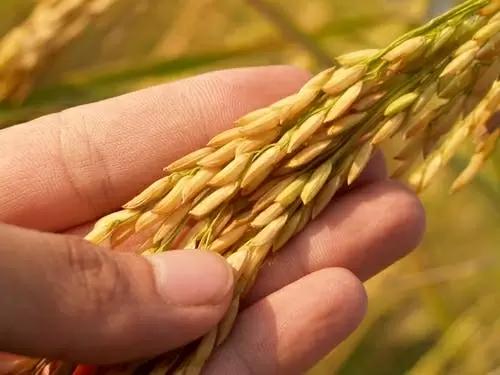Paddy, wheat still preferred crop in maximum households
New Delhi
11-September-2021

PHOTO: IANS
Paddy in kharif season and wheat in rabi season are still the preferred produce in highest percentage of agricultural households across rural India, the National Statistical Office (NSO) reported in its 77th round of survey.
The theme was 'Land and Livestock Holdings of Households and Situation Assessment of Agricultural Households' in the rural areas of India with an integrated schedule of enquiry.
In all, 25 crops were identified to present crop-wise estimates in the report. These are paddy, jowar, bajra, maize, ragi, wheat, barley, gram, arhar (tur), urad, moong, masur (lentil), sugarcane, potato, onion, groundnut, sesamum, rapseed/mustard, coconut, sunflower seed, safflower, soyabean, niger seed, cotton and jute.
For kharif season, as much as 95.9 per cent sugarcane was sold, followed by soyabean (94.4 per cent) and cotton (94.6 per cent), all being the cash crops sold 90 per cent and above; followed by groundnut (77.6 per cent), coconut (61.2 per cent) and arhar (60.4 per cent) to a large extent, that is above 60 per cent.
Rest of the crops for which the agriculture households reported sale ranged from 52.6 per cent paddy; 50.5 per cent urad; 48.1 per cent jowar; 48.6 per cent bajra; 48.5 per cent potato; 44.8 per cent moong and 36.3 per cent for ragi.
Average gross cropped area per agricultural household reporting production of crop remained less than 1.0 Ha except for soyabean and cotton, which remained less than 1.5 Ha. The harvested quantity produced (kg/number) ranged from 37,474 kg of sugarcane to 2,035 kg of paddy to nearly 1200 kg of soyabean and cotton.
Watch This TWL Video
The value of total production ranged for maximum Rs 1,01,625 for sugarcane to Rs 9,154 for ragi, the survey said.
Similarly, for rabi crop, the percentage of crop producing agricultural households reporting sale of a particular crop that they grow, it is wheat all over at 41.2 per cent while remaining others was 10 per cent or less.
The percentage of crop producing agricultural households reporting sale of the respective crop was sugarcane at 95.7 per cent; cotton at 90.7 per cent; maize at 82 per cent and paddy at 76.6 per cent and for the rest of the crops, it was 65 per cent and less.
Average gross cropped area per agricultural household reporting production of crop remained less than 1.0 Ha except for cotton, which was 1.13 Ha. The harvested quantity produced (kg/number) ranged from 34,774 kg of sugarcane to 191 kg of moong.
The value of total production ranged for maximum Rs 1,05,189 for sugarcane to Rs 9,608 for moong. The total value of production includes value of harvested crop, pre-harvest sale and value of by-products.
Prior to 77th round, Land and Livestock Holding Surveys (LHS) and Situation Assessment Survey (SAS) of agricultural households used to be conducted as separate surveys in separate sets of households.
The information was collected in two visits from the same set of sample households in rural areas with a view to collect relevant information separately for the two halves of the agricultural year from July 2018-June 2019. The first visit was made during January-August 2019 and the second during September-December 2019.
An agricultural household for National Statistical Survey's 77th survey was defined as a household receiving more than Rs 4,000 as value of produce from agricultural activities (e.g. cultivation of field crops, horticultural crops, fodder crops, plantation, animal husbandry, poultry, fishery, piggery, bee keeping, vermiculture, sericulture, etc.) and having at least one member self-employed in agriculture either in the principal status or in subsidiary status during last 365 days.
During the period, 57-58,000 households and 45,000-odd agriculture households were surveyed - IANS
More Headlines
Trinamool To Hold Protest Rallies On Monday Against Amit Shah’s Ambedkar Remarks: Mamata Banerjee
Five-Time Haryana CM Om Prakash Chautala Passes Away at 89
DMK Plans Protests Across Tamil Nadu Over HM Shah’s Ambedkar Remarks
BJP MP Alleges Rahul Gandhi Pushed Him, LoP Dismisses Claim
Passengers May Face Inconvenience With ‘Rail Roko’ Protest In Punjab
Trinamool To Hold Protest Rallies On Monday Against Amit Shah’s Ambedkar Remarks: Mamata Banerjee
Five-Time Haryana CM Om Prakash Chautala Passes Away at 89
DMK Plans Protests Across Tamil Nadu Over HM Shah’s Ambedkar Remarks
BJP MP Alleges Rahul Gandhi Pushed Him, LoP Dismisses Claim
Passengers May Face Inconvenience With ‘Rail Roko’ Protest In Punjab










